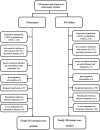Risk factors and outcomes of intraoperative hypothermia in neonatal and infant patients undergoing general anesthesia and surgery
- PMID: 37009296
- PMCID: PMC10050592
- DOI: 10.3389/fped.2023.1113627
Risk factors and outcomes of intraoperative hypothermia in neonatal and infant patients undergoing general anesthesia and surgery
Abstract
Objective: The incidence of intraoperative hypothermia remains high in pediatric patients during anesthesia and surgery even though core body temperature monitoring and warming systems have been greatly improved in recent years. We analyzed the risk factors and outcomes of intraoperative hypothermia in neonates and infants undergoing general anesthesia and surgery.
Methods: The data on the incidence of intraoperative hypothermia, other clinical characteristics, and outcomes from electronic records of 1,091 patients (501 neonates and 590 infants between 28 days and 1 year old), who received general anesthesia and surgery, were harvested and analyzed. Intraoperative hypothermia was defined as a core temperature below 36°C during surgery.
Results: The incidence of intraoperative hypothermia in neonates was 82.83%, which was extremely higher than in infants (38.31%, p < 0.001)-the same as the lowest body temperature (35.05 ± 0.69°C vs. 35.40 ± 0.68°C, p < 0.001) and the hypothermia duration (86.6 ± 44.5 min vs. 75.0 ± 52.4 min, p < 0.001). Intraoperative hypothermia was associated with prolonged PACU, ICU, hospital stay, postoperative bleeding, and transfusion in either age group. Intraoperative hypothermia in infants was also related to prolonged postoperative extubation time and surgical site infection. After univariate and multivariate analyses, the age (OR = 0.902, p < 0.001), weight (OR = 0.480, p = 0.013), prematurity (OR = 2.793, p = 0.036), surgery time of more than 60 min (OR = 3.743, p < 0.001), prewarming (OR = 0.081, p < 0.001), received >20 mL/kg fluid (OR = 2.938, p = 0.004), and emergency surgery (OR = 2.142, p = 0.019) were associated with hypothermia in neonates. Similar to neonates, age (OR = 0.991, p < 0.001), weight (OR = 0.783, p = 0.019), surgery time >60 min (OR = 2.140, p = 0.017), pre-warming (OR = 0.017, p < 0.001), and receive >20 mL/kg fluid (OR = 3.074, p = 0.001) were relevant factors to intraoperative hypothermia in infants along with the ASA grade (OR = 4.135, p < 0.001).
Conclusion: The incidence of intraoperative hypothermia was still high, especially in neonates, with a few detrimental complications. Neonates and infants each have their different risk factors associated with intraoperative hypothermia, but younger age, lower weight, longer surgery time, received more fluid, and no prewarming management were the common risk factors.
Keywords: infant; intraoperative hypothermia; neonate; perioperative hypothermia; pre-warming; thermal management.
© 2023 Zhao, Le, Chu, Gao, Zhang, Fan, Ma, Hu and Lai.
Conflict of interest statement
The authors declare that the research was conducted in the absence of any commercial or financial relationships that could be construed as a potential conflict of interest.
Figures


Similar articles
-
Intraoperative hypothermia in the neonate population: risk factors, outcomes, and typical patterns.J Clin Monit Comput. 2023 Feb;37(1):93-102. doi: 10.1007/s10877-022-00863-9. Epub 2022 Apr 22. J Clin Monit Comput. 2023. PMID: 35451677 Free PMC article.
-
Effects of a preoperative forced-air warming system for patients undergoing video-assisted thoracic surgery: A randomized controlled trial.Medicine (Baltimore). 2020 Nov 25;99(48):e23424. doi: 10.1097/MD.0000000000023424. Medicine (Baltimore). 2020. PMID: 33235123 Free PMC article. Clinical Trial.
-
Risk factors for intraoperative hypothermia in infants during general anesthesia: A retrospective study.Medicine (Baltimore). 2023 Aug 25;102(34):e34935. doi: 10.1097/MD.0000000000034935. Medicine (Baltimore). 2023. PMID: 37653751 Free PMC article.
-
Perioperative thermoregulation and temperature monitoring.Anesthesiol Clin. 2006 Dec;24(4):823-37. doi: 10.1016/j.atc.2006.09.001. Anesthesiol Clin. 2006. PMID: 17342966 Review.
-
Clinical complications, monitoring and management of perioperative mild hypothermia: anesthesiological features.Acta Biomed. 2007 Dec;78(3):163-9. Acta Biomed. 2007. PMID: 18330074 Review.
Cited by
-
Improving Postoperative Pediatric Recovery by Efficient Recovery Room Care-A Comprehensive Review.Children (Basel). 2025 Apr 28;12(5):568. doi: 10.3390/children12050568. Children (Basel). 2025. PMID: 40426747 Free PMC article. Review.
-
Intraoperative hypothermia in patients with laparoscopic surgery: Influencing factors and prevention strategies.Heliyon. 2024 May 17;10(10):e31479. doi: 10.1016/j.heliyon.2024.e31479. eCollection 2024 May 30. Heliyon. 2024. PMID: 38831829 Free PMC article.
-
Enhanced recovery protocol for congenital duodenal obstruction - initial experiences with development and implementation.Pediatr Surg Int. 2024 Dec 27;41(1):49. doi: 10.1007/s00383-024-05951-2. Pediatr Surg Int. 2024. PMID: 39729101 Free PMC article.
-
A prospective randomized study of the efficacy of continuous active warming in patients undergoing laparoscopic gastrectomy.BMC Gastroenterol. 2025 Mar 14;25(1):174. doi: 10.1186/s12876-025-03729-x. BMC Gastroenterol. 2025. PMID: 40087578 Free PMC article. Clinical Trial.
-
Risk factors for allogeneic red blood cell transfusion in adult spinal deformity surgery.Asian Spine J. 2024 Aug;18(4):579-586. doi: 10.31616/asj.2024.0080. Epub 2024 Aug 20. Asian Spine J. 2024. PMID: 39164025 Free PMC article.
References
LinkOut - more resources
Full Text Sources

